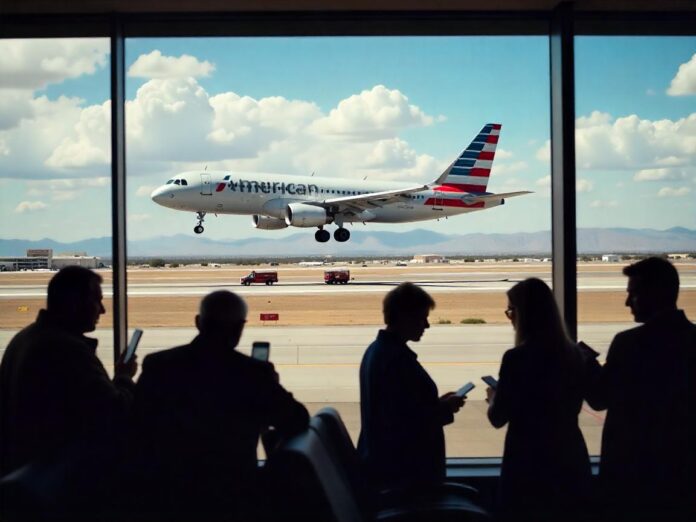American Airlines Flight AA2690: A Mid-Flight Emergency That Shook the Skies
Passengers aboard American Airlines Flight AA2690 were geared up for a routine jaunt from Las Vegas to Los Angeles, eager for the short trip filled with entertainment or business. However, mid-flight, their expectations collided with reality when the flight declared a Squawk 7700 emergency, signaling a serious in-flight issue. This unexpected turn sent ripples through the travel community and ignited conversations about airline safety and emergency protocols.
Understanding Squawk 7700
For those unacquainted, "Squawk 7700" isn’t just aviation jargon; it’s a call for urgent assistance. When a pilot issues this code, air traffic controllers immediately prioritize that flight, redirecting other aircraft and ensuring emergency services are on alert. This protocol is critical for managing the complexities of airspace and ensuring the safety of everyone involved.
The implications of a Squawk 7700 event extend beyond the flight itself. It often leads to a domino effect in the operational schedules of airlines, requiring immediate investigations and aircraft inspections. For the airline, the fallout might mean a significant loss of revenue as planes get grounded for maintenance or repairs.
Passenger Sentiment in Crisis
For the passengers on Flight AA2690, the activation of the emergency code triggered a wave of anxiety. As the Airbus A321neo veered back toward Las Vegas, the cabin atmosphere became palpable with tension. Social media quickly buzzed with accounts of the experience, some passengers sharing photos of their alarm while others expressed their appreciation for the crew’s handling of the situation.
Even with a successful landing, such experiences can linger in the minds of passengers, altering their perception of flying with that airline. In the age of instant online communication, any mishap can ripple through social networks, prompting discussions that can affect brand reputation for years to come.
Economic Impact on Travel Corridors
The Las Vegas–Los Angeles corridor serves as a crucial artery for air travel, catering to a mix of tourism and business activities. Disruptions like Flight AA2690 can have severe implications on local economies. Hotels and entertainment venues in both cities thrive on the consistent inflow of visitors, and any hiccup in travel can ripple through these industries.
When one flight faces emergencies, it can lead to increased demand on remaining flights and consequently affect ticket prices. Passengers often find themselves scrambling for new arrangements or accommodations, resulting in frustration and unexpected costs.
Balancing Act for Travel Businesses
For travel agencies and businesses within the tourism sector, managing the fallout from an event like this can be a balancing act. They need to reassure customers of their safety while acknowledging the gravity of the situation. Travel agents find themselves fielding calls from anxious clients about rerouting and refunds, while hoteliers brace for cancellations or last-minute booking changes.
The perception of safety in airlines is paramount. In today’s easily accessible information age, a quick response to incidents can make a substantial difference in maintaining trust among travelers.
Regulatory Response and Safety Protocols
Regulatory bodies will undoubtedly scrutinize the incident in detail. Modern aircraft like the Airbus A321neo come equipped with sophisticated systems designed to ensure passenger safety, yet even minor issues can spark significant inspections and safety protocols.
If root causes relate to pressurization failures, it may prompt broader safety reviews and potential changes to operational procedures. Such measures are imperative not only for ensuring passenger safety but also for restoring public confidence in the airline industry.
Financial Outcomes of Emergencies
The financial implications of an emergency landing are significant, with losses compounding through cancelled boarding and unforeseen operational costs. Returning to Las Vegas rather than completing the intended route impacts American Airlines’ bottom line through lost fares and additional expenditure on fuel and emergency services.
These costs can become even more pronounced during the summer travel season when air traffic peaks, making revenue generation critically important for airlines.
Crew Dynamics in High-Pressure Situations
In emergencies, airline crew members—pilots and cabin staff alike—face immense stress. Their training equips them for such moments, yet the human factor is always present. Following an emergency, they navigate the complexities of disrupted schedules, ensuring they adhere to regulations governing fatigue and duty hours.
Airlines must strike a balance between operational needs and crew well-being, a demanding task in an industry where every moment counts.
Emergency Preparedness at Harry Reid International Airport
Harry Reid International Airport, a bustling hub, had to react swiftly when Flight AA2690 returned. Coordinating emergency services and managing logistics while keeping travelers informed is no small feat. Such incidents test airport preparedness and collaboration among various stakeholders.
Las Vegas’s economy relies heavily on the effectiveness of its airports, making effective emergency management pivotal in safeguarding the flow of visitors to the city.
The Role of Real-Time Flight Tracking
Digital platforms such as FlightRadar24 allow the public to track flights in real time, amplifying the transparency of aviation incidents. While this accessibility fosters trust, it also escalates public anxiety during emergencies.
Details about altitude drops or sudden course corrections can lead to speculation, often before official statements are disseminated. Immediate, clear communication becomes essential in quelling fears and maintaining a cooperative relationship between airlines and their customers.
Navigating the Post-Emergency Landscape
For travelers, Flight AA2690’s emergency serves as a stark reminder about the unpredictability of air travel. It emphasizes the importance of choosing flexible booking options and being prepared for disruptions.
For the airline industry, it showcases the necessity for robust crisis management plans and proactive communication strategies. Airlines that effectively address issues and reassure customers stand a better chance of retaining loyalty long after the incident has been resolved.
As the investigation into this emergency continues, the implications for American Airlines and the broader aviation industry will unfold, shaping future practices and protocols in flight safety standards.
